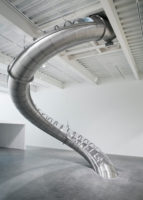Secretary General Ban Ki-Moon spoke, as did the crown princess of Denmark, but at a grand opening for the renovated Trusteeship Council Chamber at the United Nations headquarters in New York on Thursday morning, all eyes were on the ceiling. Danish master Finn Juhl designed the meeting hall with Lego-like metal boxes hanging overhead. They conceal the chamber’s lighting and ventilation systems behind brightly colored panels that interrupt the spindles in a series of wooden frames.
Designed when Juhl was only in his late 30s and opened in 1952, the ceiling and wall panels were taken down and restored during the renovation. The update also added seating to accommodate large meetings—the space can now host more than 600 people. The Danish Heritage Agency oversaw the project, and design firm Salto & Sigsgaard won a competition to introduce their own contemporary furniture to the chamber. “We wanted to show what we’re doing now,” says Kasper Salto, “while blending in like a fish in water with Juhl's work.”
The project brought back Juhl’s original horseshoe-shaped plan, lost in earlier renovations, which wraps curving rows of delegates’ desks around a slightly sunken secretariat table. (The rounded configuration and level floor plane diminsh the appearance of hierarchies among delegations.) Officials seated directly behind the desks sit in narrow versions of Juhl’s FJ51 chair (1951), while assistants behind them use more modest seats covered in chartreuse leather.
Salto and Sigsgaard, a cabinet maker and an architect by training, designed the desks with curved wooden surfaces. They had initially wanted to mimic the walnut of Juhl’s chair in the finish, but, the designers explained at the opening, some U.N. delegates preferred a material that would bounce light up onto their faces when they are on video, so Salto and Sigsgaard went with a brighter white oak.
The firm also used oak for the Council Chair (2013), a new design created to accompany the secretariat table. Its squat, rhombus-shaped back pivots slightly away from a swooping, stingray-like seat and armrest. The designers padded its two thin wood forms with a light leather and supported them with an aluminum frame. “It’s a very Juhl type of chair in the way that its meets the body,” says Thomas Sigsgaard, explaining that the separation of the structure from the contoured shell follows Juhl’s humanist softening of a Modernist geometry. The injection-molded aluminum also makes the chair affordable for a commercial market.
At the opening, Salto & Sigsgaard’s Council Chairs flanked the crown princess of Denmark as she introduced the space from a podium. The Danish government funded about one third of the original cost to furnish the chamber back in 1952. The new renovation project is part of a massive overhaul of the U.N. complex, to which Denmark has committed $3.3 million. It included the renovation of the Secretariat building, which reopened last year, and will end in 2014 with the completion of the General Assembly.
On Thursday, the secretary general’s remarks referenced both the history of the Trusteeship Council—the now-disbanded organizaion once shepherded former colonies to self-governance and U.N. membership—and also Juhl’s democratic configuration of desks. Praising the renovation, he said, “This an inclusive room where everyone can communicate.”













